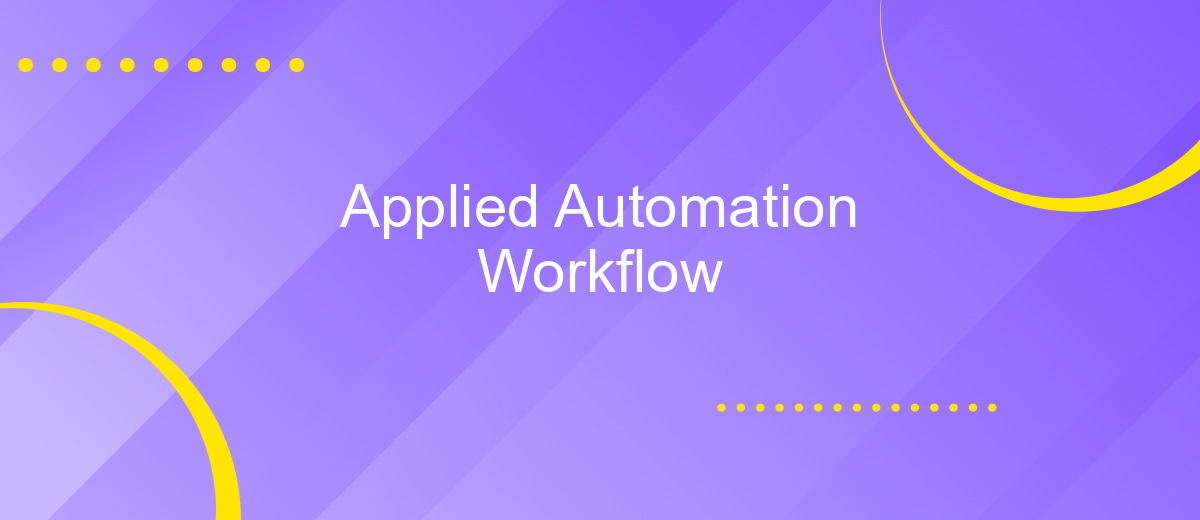Applied Automation Workflow
In today's fast-paced industrial landscape, the implementation of applied automation workflows has become essential for optimizing efficiency and productivity. By integrating advanced technologies and streamlined processes, businesses can minimize human error, reduce operational costs, and enhance overall performance. This article explores the key components and benefits of applied automation workflows, providing insights into how they can transform modern operations.
Introduction
In today's fast-paced digital world, businesses are increasingly turning to automation to streamline their workflows and enhance productivity. Applied automation workflow refers to the systematic approach of integrating automation tools and technologies into various business processes to achieve optimal efficiency and accuracy. This practice not only minimizes human error but also allows employees to focus on more strategic tasks.
- Reduction of manual tasks
- Improved accuracy and consistency
- Enhanced scalability
- Better resource allocation
One of the key components in setting up an effective automation workflow is the integration of various software and services. Tools like ApiX-Drive facilitate seamless integration by connecting different applications and automating data transfer between them. This ensures that your business processes run smoothly and efficiently, without the need for constant manual intervention. By leveraging such services, organizations can significantly improve their operational efficiency and stay competitive in the ever-evolving market landscape.
Benefits of Applied Automation

Applied automation significantly enhances efficiency by streamlining repetitive tasks and minimizing human error. By automating workflows, businesses can redirect their workforce towards more strategic activities, leading to increased productivity and innovation. Automation tools can handle complex processes with precision, ensuring consistency and reliability across various operations. This not only saves time but also reduces operational costs, making businesses more competitive in their respective markets.
Moreover, applied automation facilitates seamless integration of different systems and applications, improving data flow and communication within an organization. Tools like ApiX-Drive enable businesses to easily set up and manage integrations without requiring extensive technical expertise. This allows for real-time data synchronization, providing valuable insights and enhancing decision-making processes. Overall, the adoption of applied automation leads to a more agile and responsive business environment, capable of adapting to changing market demands and technological advancements.
Types of Applied Automation Systems

Applied automation systems play a crucial role in enhancing efficiency and accuracy in various industries. They can be categorized into several types, each serving specific functions and offering unique benefits.
- Robotic Process Automation (RPA): This type focuses on automating repetitive tasks that do not require human decision-making. RPA can handle data entry, invoice processing, and other routine activities.
- Industrial Automation: Utilized in manufacturing and production environments, industrial automation systems control machinery and processes to improve production speed and quality.
- Business Process Automation (BPA): BPA systems streamline business workflows by automating complex processes such as order fulfillment, customer service, and supply chain management.
- Integration Automation: Services like ApiX-Drive facilitate the seamless integration of various software applications, allowing different systems to communicate and work together efficiently.
Each type of applied automation system offers distinct advantages, from reducing manual labor to enhancing data accuracy and operational efficiency. By leveraging these systems, businesses can achieve significant improvements in productivity and service quality.
Implementation of Applied Automation

Implementing applied automation involves a structured approach to streamline and optimize workflows. The first step is to identify repetitive tasks that can be automated, such as data entry, reporting, and communication processes. This helps in reducing manual effort and minimizing errors.
Once tasks are identified, selecting the right tools and platforms is crucial. Tools like ApiX-Drive can be instrumental in setting up integrations between various applications, ensuring seamless data flow and synchronization. ApiX-Drive allows users to connect different services without coding, making it accessible for non-technical users.
- Identify repetitive tasks
- Select appropriate automation tools
- Set up integrations using platforms like ApiX-Drive
- Monitor and optimize automated workflows
After setting up the automation, continuous monitoring and optimization are essential. Regularly reviewing the automated processes ensures they are functioning as intended and provides opportunities for further enhancement. By following these steps, organizations can achieve significant efficiency gains and focus more on strategic activities.
Case Studies and Best Practices
In recent years, numerous companies have successfully implemented applied automation workflows to streamline their operations and enhance productivity. For instance, a leading e-commerce platform integrated various automation tools to manage their inventory, order processing, and customer support. By utilizing ApiX-Drive, they were able to seamlessly connect different software applications, ensuring real-time data synchronization and reducing manual interventions. This integration not only improved their operational efficiency but also enhanced customer satisfaction by providing timely and accurate information.
Another notable example is a financial services firm that adopted automation to handle their routine compliance checks and reporting. By leveraging ApiX-Drive, they connected their internal systems with external regulatory databases, automating data retrieval and report generation. This approach minimized human errors and ensured compliance with regulatory requirements. These case studies highlight the importance of choosing the right tools and best practices in applied automation workflows to achieve optimal results and maintain a competitive edge in the market.
FAQ
What is Applied Automation Workflow?
How can automation benefit my business?
What types of tasks can be automated?
How do I get started with automation?
Is it difficult to implement automation in my existing systems?
Strive to take your business to the next level, achieve your goals faster and more efficiently? Apix-Drive is your reliable assistant for these tasks. An online service and application connector will help you automate key business processes and get rid of the routine. You and your employees will free up time for important core tasks. Try Apix-Drive features for free to see the effectiveness of the online connector for yourself.

